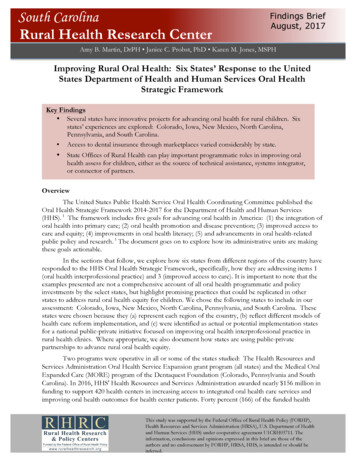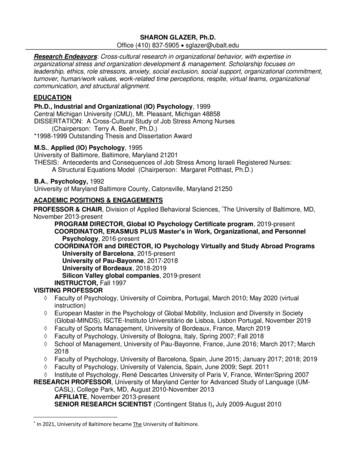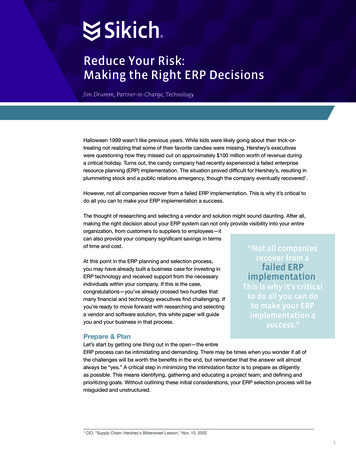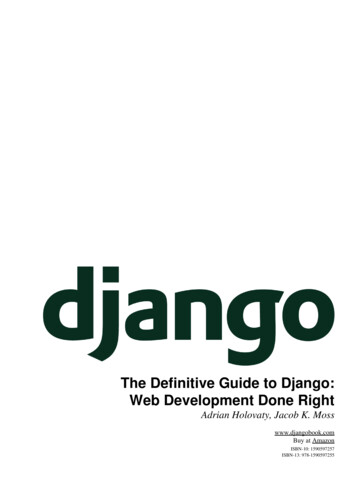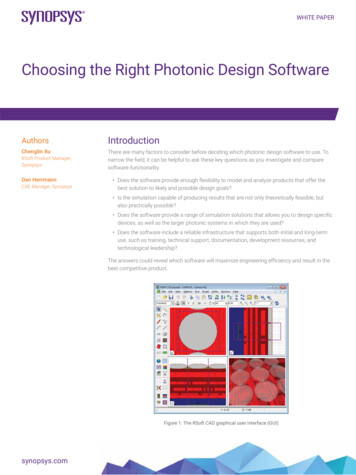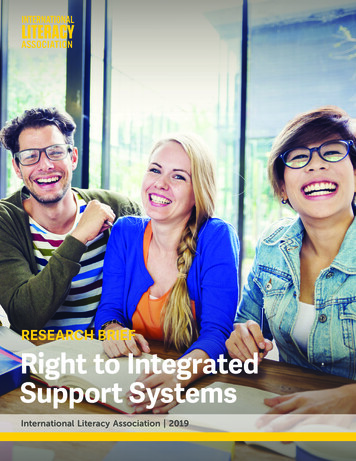
Transcription
RESEARCH BRIEFRight to IntegratedSupport SystemsInternational Literacy Association 2019
Children have the right to integrated support systems: Student learningdepends on the successful alignment of a complex system of stakeholders working cooperatively to strengthen teaching and learning practicesand knowledge-building frameworks. Integrated support systems mustbe inclusive of students, classroom teachers, reading/literacy specialists,school staff, school leaders, families and caregivers, volunteers, and community members. Researchers, policymakers, and global partners playkey roles as well. Learning occurs as a result of overlapping, multifacetedspheres of influence, and when this complexity of education systems isrecognized, there is a stronger likelihood that all stakeholders will workas partners toward the same, collective goal.—Children’s Rights to Excellent Literacy InstructionTForging strong connectionsand fostering productivecol laborations.areessential to creating ahigh-quality integratedsystem of support.here’s no one-size-fits-all formula for student supportsystems, but the relationships between the variousstakeholders—everyone from classroom teachersand school librarians to families and communitymembers—directly impact on success. So although recognizingwho plays a part in these systems is important, we also need tofocus on how they work together.Forging strong connections and fostering productive collaborations through learning ecologies, dialogic relationshipsand teaching, and professional learning communities (PLCs)are all essential to creating a high-quality integrated system ofsupport.Learning EcologiesResearchers such as Bronfenbrenner (2005), Reinking andBradley (2011), and Zhao and Frank (2003) have used the metaphor of the learning ecology to describe the evolving, multilevel,dynamic, transactional interplay and interdependency betweenmultiple actors and multiple variables operating within schoolsor educational settings. We use the term integration to indicatethe need for productive connections between these elements.A school learning ecology involves the curriculum, the teaching pedagogies, and the relationship between not only studentsand teachers but also students and their peers in a social learning environment. It also involves the relationships and socialcapital of class teachers in their relationships with their colleagues, with school administrators, and with families andcaregivers within a wider school and social and political community (Ell, Simpson, Mayer, Davies, Clinton, & Dawson, 2019).Finally, it involves the infrastructure, the physical setting, and the availability of resources, including technologies.2
Children have the right tobe provided with a suite ofsystems that areproduc tively aligned.Learning is orchestrated through the development of culturallyappropriate, multimodal literacies. As children are immersedin the literacy practices of their community and school, allof these elements provide support to learners in one way oranother.We adopt the meaning of the right to integrated support systems to refer to a broad, sociological concept. As the right tointegrated support systems includes contextualized, localized,and community-based services, we deliberately dissociate itfrom the initialism RTI (Response to Intervention). The principles of RTI are valuable as they are premised on educators whomake quality interventions on a needs basis to make a difference in student learning.However, the strict model of RTI as a multitiered approachcontrolled by screening is too narrow a frame to include moreadaptive and site-specific support and the involvement of thoseoutside the frame of formal learning. We believe children havethe right to be provided with a suite of systems that are productively aligned whether they are accessed at school, in a libraryor any other kind of education center, or at home.Child psychologists and social researchers recognize thatschool, community, and family play important roles in how children develop. However, these impacts change when consideringthe birth-to-school continuum, or birth-to-adolescent developmentof learners. As children begin to receive formal schooling, family has a lesser impact, whereas peer and community contextsbegin to play a role.For example, a strong family influence is often seen in theearly years from birth, with an increasing school influencewhen children attend a daycare, preschool, or kindergarten. Peer groups and community begin to have a strongerimpact on children in the primary years, a gap that is oftenever-widening through the upper grades (Scully, Stites,Roberts-King, & Barbour, 2018). If consistent and positive messages of support indicate that the school, community, and family are working together to achieve similar outcomes, the skybecomes the limit for growing learners. To broaden learningperspectives, partnerships with researchers at colleges anduniversities, along with outreach to families, caregivers, andcommunities, are crucial.3
Dialogic Relationships and TeachingDialogue is essential in theconsideration of literacypractices, as inclusiveinteraction is crucial toboth learning and teach ing.Dialogue is essential in the consideration of literacy practices,as inclusive interaction is crucial to both learning and teaching. The word dialogue implies two-way conversation, a spacein which respectful discussion takes place. The concept of dialogic teaching was theorized by Robin Alexander who studiedchildren learning in classrooms around the world (Alexander,2001). He noted that learning was successful in environmentsthat “harness the power of talk to engage children, stimulateand extend their thinking, and advance their learning andunderstanding” (Alexander, 2004, p. 37). Alexander’s dialogicprinciples are as follows: Collective: Educators and learners address learning taskstogether, whether as a group or as a class. Reciprocal: Educators and learners listen to each other,share ideas, and consider alternative viewpoints. Supportive: Learners articulate their ideas freely, withoutfear of embarrassment over wrong answers. Cumulative: Educators and learners build on their own andothers’ ideas and chain them into coherent lines of thinking and enquiry. P urposeful: The dialogue is planned and transacted withspecific learning outcomes clearly in view. (Alexander,2004, p. 38)Research into the use of dialogue has expanded into manydifferent contexts and each one upholds the power of dialogueas a catalyst for learning. In addition, researchers have demonstrated that through dialogic teaching, students make improvements in learning outcomes. Dialogic teaching is particularlygeared toward addressing underachievement in high-povertyschool districts, revealing that the deliberate use of a broadrepertoire of collaborative talk patterns leads to increases inliteracy achievement for all students across different curriculum areas (Alexander, 2017; Simpson, 2016).4
Building Shared Understandingof Literacies Through PLCsAccess to comprehensive databases with summative and formative data demonstrating students’ proficiencies in readingand writing, as well as identified areas of needed improvement,is available to those supporting the literacy development of ourlearners. Schools committed to fostering PLCs will use thesedata to drive efforts around professional development whileinforming strategic planning processes that address instructional programs.Communities of practice create opportunities for individualsto work with others to do the following: Interact socially to co-construct understandings aroundliteracy best practices Grow from new conceptualized understandings Observe instruction in model classrooms Self-direct and choose next steps for continuous improvement (Tracey & Morrow, 2017)When these components are ingrained in the culture of a school,literacy stakeholders, including families and caregivers, can engage in worthwhile conversations aimed at creating a shared understanding as to how they can work together to improve literacyteaching and learning and, therefore, impact student achievement.Well-developed PLCs realize this mission because of a focus ondeveloping educators’ knowledge of literacy practices: “Throughcollaborative inquiry, teachers explore new ideas, current practice, and evidence of student learning using practices that respect them as the experts on what is needed to improve theirown practice and increase student learning” (Vescio, Ross, &Adams, 2008, p. 89).Working Together for a Better FutureSchool communities mustfocus on enhancing theirlearning ecology.Our children deserve nothing less than a high-quality integratedschool experience where support systems work together to focuson increasing students’ academic, social, personal, and emotionalwell-being. School communities must focus on enhancing theirlearning ecology, taking a pulse of what supports are working welland creating actions to improve those in need of improvement.5
This research brief expands on the second of four tenets that compose theInternational Literacy Association’s Children’s Rights to Excellent LiteracyInstruction position statement: rightstoread.org/statementBIBLIOGRAPHYAlexander, R. (2001). Culture and pedagogy: Internationalcomparisons in primary education. Oxford, England:Blackwell.Alexander, R. (2004). Towards dialogic teaching:Rethinking classroom talk. Cambridge, England:Dialogos.Alexander, R. (2017, August). Developing dialogue:Process, trial, outcomes. Paper presented at the 17thBiennial EARLI Conference, Tampere, Finland.Bronfenbrenner, U. (2005). Ecological systems theory(1992). In U. Bronfenbrenner (Ed.), Making human beings human: Bioecological perspectives on human development (pp. 106–173). Thousand Oaks, CA: Sage.Darling, S. (2005). Strategies for engaging parents inhome support of reading acquisition. The ReadingTeacher, 58(5), 476–479. Retrieved from https://doi.org/10.1598/RT.58.5.8Ell, F., Simpson, A., Mayer, D., Davies, L.M., Clinton,J., Dawson, G. (2019). Conceptualising the impactof initial teacher education. Australian EducationalResearcher, 46(1), 177–200.Hicks, T., Sailors, M., & International LiteracyAssociation. (2018). Democratizing professional growthwith teachers: From development to learning [Literacyleadership brief]. Newark, DE: International LiteracyAssociation. Retrieved from th-with-teachers.pdfInternational Literacy Association. (2017). Early literacylearning for immigrant and refugee children: Parents’critical roles [Literacy leadership brief]. Newark, DE:Author. Retrieved from nt-refugee-children.pdf?sfvrsn b60ca58e 10International Literacy Association. (2018). Transformingliteracy teacher preparation: Practice makes possible [Literacy leadership brief]. Newark, DE: Author.Retrieved from reparation.pdfJuzwik, M.M., Dunn, M., & Johnson, A. (2016, April14). From dialogic tools to a dialogic stance.Literacy Daily. Retrieved from https://literacyworldw ide.org /blog /literacy-da tanceReinking, D., & Bradley, B.A. (2011). Revisiting the connection between research and practice using formative and design experiments. In N.K. Duke & M.H.Mallette (Eds.), Literacy research methodologies (2nded., pp. 188–212). New York, NY: Guilford.Simpson, A. (2016). Dialogic teaching in the initialteacher education classroom: “Everyone’s voice willbe heard.” Research Papers in Education, 31(1), 89–106.Stahl, K.A.D. (2015). Using professional learning communities to bolster comprehension instruction.The Reading Teacher, 68(5), 327–333. Retrieved fromhttps://doi.org/10.1002/trtr.1311Tracey, D.H., & Morrow, L.M. (2017). Lenses on reading:An introduction to theories and models (3rd ed.). NewYork, NY: Guilford.Vescio, V., Ross, D., & Adams, A. (2008). A review of research on the impact of professional learning communities on teaching practice and student learning.Teaching and Teacher Education: An InternationalJournal of Research and Studies, 24(1), 80–91.Zhao, Y., & Frank, K.A. (2003). Factors affecting technology uses in schools: An ecological perspective.American Educational Research Journal, 40(4),807–840.6
International Literacy Association: Children’s Rights to Excellent Literacy InstructionCommitteePrincipal AuthorsBernadette Dwyer, Dublin City University, IrelandKenneth Kunz, Monmouth UniversityAlyson Simpson, University of SydneyCommittee MembersSachiko Adachi, Niigata UniversityRita M. Bean, University of PittsburghJuli-Anne Benjamin, Marion P. Thomas Charter SchoolWendy Carss, University of WaikatoJim V. Hoffman, University of North TexasJacy Ippolito, Salem State UniversityDiane Kern, University of Rhode Island, KingstonHenry “Cody” Miller, SUNY College at BrockportJennifer Williams, Calliope Global Education InitiativesKathy N. Headley, Clemson University, President and Board Liaison, International Literacy AssociationBernadette Dwyer, Dublin City University, Ireland, Immediate Past President, International Literacy AssociationStephen Peters, Laurens County School District 55, Vice President, International Literacy AssociationMarcie Craig Post, Executive Director, International Literacy Association 2019 International Literacy Association No. 9455This research brief is available in PDF form for free download through the International Literacy Association’s website:literacyworldwide.org/statements and rightstoread.org/statement.Media Contact: For all media inquiries, please contact press@reading.org.Suggested APA ReferenceInternational Literacy Association. (2019). Right to integrated support systems [Research brief]. Newark, DE: Author.About the International Literacy AssociationThe International Literacy Association (ILA) is a global advocacy and membership organization dedicated to advancing literacyfor all through its network of more than 300,000 literacy educators, researchers, and experts across 146 countries. With over60 years of experience, ILA has set the standard for how literacy is defined, taught, and evaluated. ILA’s Standards for thePreparation of Literacy Professionals 2017 provides an evidence-based benchmark for the development and evaluation ofliteracy professional preparation programs. ILA collaborates with partners across the world to develop, gather, and disseminatehigh-quality resources, best practices, and cutting-edge research to empower educators, inspire students, and informpolicymakers. ILA publishes The Reading Teacher, Journal of Adolescent & Adult Literacy, and Reading Research Quarterly,which are peer reviewed and edited by leaders in the field. For more information, visit onalLiteracyAssociationliteracyworldwide.org7
high-quality integrated system of support. Children have the right to integrated support systems: Student learning depends on the successful alignment of a complex system of stakehold-ers working cooperatively to strengthen teaching and learning practices and knowledge-building frameworks.



